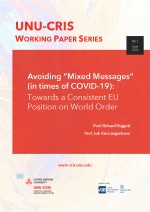From Trade Led to Monetary-Led Regionalism: Why Asia in the 21st Century Century will be Different to Europe in the 20th Century
The financial crises of the late 1990s marked an intellectual watershed for the global economy, and also for regionalism as the Janus face of globalisation. At the beginning of the 21st century, the theory and practice of regional cooperation and integration may evolve along different lines to how it was understood for most of the second half of the 20th century. In East Asia, in particular, this will mean that the relationship between multilateralism and regionalism will change. The ‘East Asian’ region will become an increasingly important domain within which to explore enhanced protection against financial crises. What we might call ‘monetary regionalism’, sceptical western voices notwithstanding, is now firmly on the regional agenda in East Asia. Within conventional political economy, the theory and practice of monetary regionalism is not as easy to understand as traditional, trade driven, regional integration. Thus one aim of this paper is to outline a theory of monetary regionalism and demonstrate the degree to which it represents not only a break with the interpretation of the regional project in East Asia prior to the late 1990s but also with that of Europe in the second half of the 20th century. From its start in 1989, APEC claimed to be a new type of regionalism. The promise was that APEC would promote open regionalism. APEC did not achieve this goal. Nor did it provide support to its Asian members during the financial crises of the late 1990s. At the same time, more traditional (what we might call Balassian) trade driven regional integration of the kind used to explain development of the European Community, are showing signs of decreasing importance. In Asia, there is a growing interest in trade co-operation, but notably reflected in bilateral preferential trading arrangements. This leads to a complex picture of competing regional initiatives across the economic policy spectrum in the wider context of the growing politico-economic dialogue between Southeast and Northeast Asia that has developed via the ASEAN+3 process since 1997.


